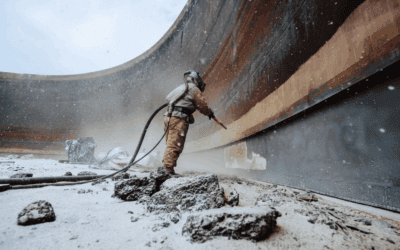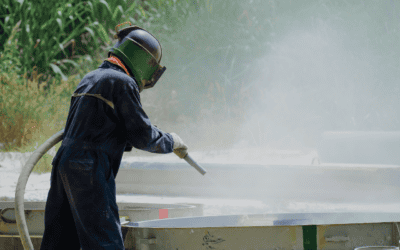Understanding blast pot pressurisation: What you might be doing wrong
If you’re experiencing inconsistent results, wasted abrasive, or unexpected downtime during blasting operations, it could be due to something surprisingly simple – incorrect blast pot pressurisation.
Your system may appear to be working, but without proper blasting pressure control, you’re likely losing efficiency and risking safety. In this blog, we’ll be exploring what proper pressure regulation looks like, common operator mistakes, and how to get your settings right for optimal blast system pressure performance.
Why correct blast pot pressurisation matters
Blast pot pressurisation is the foundation of any effective abrasive blasting operation. It’s what ensures the correct mix of air and abrasive, delivering it at the right speed and consistency through the blast nozzle.
Without adequate blast pot pressure, you’ll see:
- Poor cleaning performance.
- Inconsistent abrasive flow.
- Excessive wear on equipment.
- Increased downtime for maintenance or troubleshooting.
Correct blast system pressure ensures a steady stream of abrasive and supports safe operation throughout your blasting cycle.
Common blast pot pressurisation mistakes – and how to fix them
1. Not equalising pressure before blasting: Before you start blasting, the pot needs to be fully pressurised. If operators open the blast valve before pressure equalises inside the vessel and the blast line, the result is weak abrasive flow and sluggish blasting. Always wait for the blast pot system to reach full operating pressure before activating the blast valve. If you notice pulsing or weak blasting at startup, it may mean the pot hasn’t sealed correctly or hasn’t reached full pressure. Check that the blowdown valve is closed and wait until all exhaust air has stopped before blasting – a sign that the system has fully pressurised.
It is important to note that this is only for blast pots with a blowdown facility, as not all of them do.
2. Incorrect pressure settings for the job: Different surfaces and media require different pressure levels. Using too high a pressure can damage the substrate, while too little will reduce performance and prolong the job. Adjust the blast system pressure to match the abrasive type, nozzle size, and surface profile required. For example, harder surfaces like steel often require pressures in the range of 80-100 psi, while softer materials such as aluminium or wood need lower pressures to avoid surface damage. Always tailor your blasting pressure control to the job at hand and consult equipment manuals or your supplier for guidance on optimal settings. If your abrasive flow seems inconsistent, it may also be due to a mismatch between nozzle size, abrasive metering, and blast pressure.
3. Leaking valves or fittings: A slow leak may not stop the job outright, but it will lower pot pressure over time, affecting abrasive flow and blasting consistency. Regularly inspect the pressure vessel, valves, and hoses for wear or damage. Tighten fittings and replace worn components immediately to maintain correct abrasive pot pressure.
4. Overfilling the blast pot: An overfilled blast pot limits the available air space inside the vessel, meaning it cannot build and maintain sufficient pressure. Never fill the pot beyond the manufacturer’s recommended capacity. Leave enough headroom for air to build up and pressurise the vessel correctly.
5. Skipping regular maintenance: Like any piece of industrial equipment, a pressurised blast pot needs routine checks and servicing. Ignoring maintenance leads to clogged lines, faulty valves, and reduced pressure efficiency. Follow a strict maintenance schedule, including checking the blast hose, moisture traps, and pressure regulators. This ensures safe, reliable pressurisation and extends equipment life. You can book in your blast pot for servicing with Airblast Limited – simply get in touch with our team to set up a routine maintenance schedule.
How to maintain consistent abrasive pot pressure
- Use a moisture separator to prevent water contamination in the air line, which can affect pressure and abrasive flow.
- Monitor the nozzle wear – overworn nozzles affect back pressure and reduce efficiency.
- Don’t ignore the compressor. Make sure your air supply is dry, clean, and capable of supplying the CFM your system requires.
Operator tip: Don’t rely solely on pot pressure readings – use a needle gauge at the blast nozzle to check your actual blasting pressure. What really matters is what’s coming out at the nozzle, not just what’s measured at the tank. If your system struggles to maintain consistent pressure during operation, your compressor may be undersized or underperforming.
Final thoughts
Proper blast pot pressurisation is about more than just flipping a switch. It takes routine checks, correct procedures, and a good understanding of your equipment. Avoiding common mistakes can boost your productivity, reduce wear on components, and improve blasting performance.
If you’re unsure whether your system is running at the right pressure, or you need help setting it up, you can talk to a knowledgeable member of our sales team or schedule a training session with our experienced technicians to get the best use out of your blast equipment.
Need help with your blast equipment setup or maintenance?
We offer expert advice, servicing, and support to help you get the most from your equipment. Contact us today or explore our range of blast pots.



